 DF.2014 at the head of the 7.00 a.m. departure from Thazi.
DF.2014 at the head of the 7.00 a.m. departure from Thazi.
The train had two Upper Class Coaches in cream and brown sandwiched between 2 Ordinary Class coaches in blue and brown. Two bauxite-coloured bogie vans were at the rear. The train had vacuum brakes, supplemented by 'straight air' brakes on the locomotive.
To my amazement, the train departed dead on time. Just south of the station we crossed Thazi's dual-carriageway 'main street' on a level crossing which, unusually, had full gates rather than the usual 'half barriers'. Here, there were three running lines - our single line to Kalaw, Up Mandalay and Down Mandalay.
 Thazi Level Crossing, looking east.
Thazi Level Crossing, looking east.
After a few hundred yards, our line turned eastwards across the plain, and we passed a series of minor level crossings, each with its flagman.
 Passing a minor level crossing and approaching an outer home signal showing 'clear'.
Passing a minor level crossing and approaching an outer home signal showing 'clear'.
We made our first stop at the small station of Hlaingoet, the next at the larger station at Payangazu.
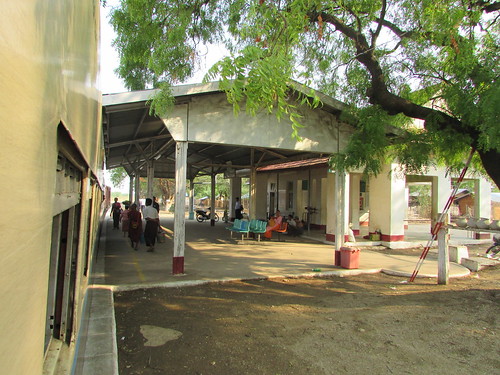 Payangazu station.
Payangazu station.
A flagman warned us across 2-span bridge number 48. Through the heat haze, the grey silhouette of the mountains was visible and loomed larger as we continued our climb. I noticed that the tops of the mountains were fringed with trees and it made me think of stubble on on an unshaved man's chin. We passed another level crossing at road marker 'km49'. Bridge 55 was traversed near a screeching reverse curve. The line twisted and turned through cuttings hewn in rock, with the loco working hard. We slowed to observe a 5 m.p.h. restriction over a tall, curving multi-span river bridge.

Crossing the tall, multi-span river bridge.
The track continued to curve to the right and were still going very slowly as we passed a large stock of concrete sleepers, apparently thrown trackside from a train ready for relaying. Looking down, I could see the tall, multi-span river bridge below us we'd just crossed. In less than five minutes, as the train climbed, we'd also turned 180 degrees.
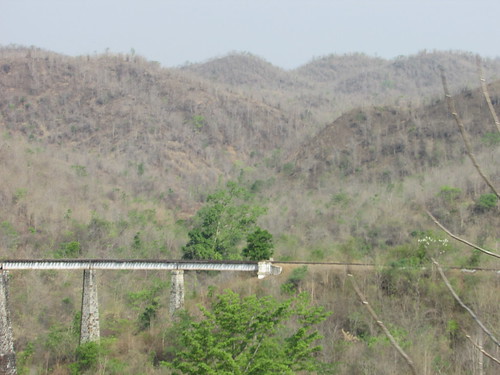 Looking down on the multi-span bridge with mountain tops fringed with trees in the background.
Looking down on the multi-span bridge with mountain tops fringed with trees in the background.
Before the railway came, this must have been fairly impenetrable forest. Our Bo-Bo-Bo locomotive was still working hard on the front of the train as we entered another cutting, whistled for a short tunnel and emerged into another cutting.
The cutting opened out on an elevated plateau with a large village. Most of the buildings were bamboo framed with woven walls but some also sported satellite dishes. There were numerous ungated crossings, some no wider than passageways. After a broader, gated road crossing we stopped at Yin Mabin station with the usual loops, one stabling a Railway Gang Car (RGC.008). Our train had stopped adjacent to an abandoned water column which, back in the days of steam, must have been a great consolation to trains struggling up the fierce gradients. Two track workers dumped their tools in the end of my coach and squatted in the vestibule as we set off.
 Track workers loading their tools at Yin Mabin.
Track workers loading their tools at Yin Mabin.
The modest station buildings had the usual ceremonial flagpole on the platform. There was also a remarkably neat stall supplying meals, nowadays supplied in the dreadful expanded polystyrene boxes. Alternately, similar food could be purchased from the various vendors who walked through the train, together with fresh fruit, bottled water bottled soft drinks and even ice lollies (from a cool box).
Yin Mabin (together with a number of other stations on the line) featured the same type of horizontal windlass I'd seen on the line to Pyin Oo Lwin. They appear to operate signal wires and I assume that they once operated home signals, allowing only one signal to be cleared at a time.
 Yin Mabin station. Note the horizontal windlass set on a circular platform on the right.
Yin Mabin station. Note the horizontal windlass set on a circular platform on the right.
Leaving Yin Mabin the terrain became fairly open as we passed over a 3-span plate truss bridge (number 104) set on stone piers and abutments. Bridge 105 was of similar construction. We passed one of the individualistic fixed distant signals - on this example, the arm extended to the right of the post! We pass a home signal with the odd-looking 'lower quadrant arm arranged for upper quadrant'.
We passed through Pyi Nyaung, provided with a platform line and two loops, without stopping. The line passed over an elderly lattice girder bridge which had been left in place but with its load taken over by modern through girders. After passing slowly through another cutting, we slowed again to pass over over a bridge where the two track workers who'd joined the train at Yin Mabin jumped down with their tools, joining a group of workers already there working to renew wooden sleepers over the bridge. I noticed I'd been travelling for two and a half hours hours.
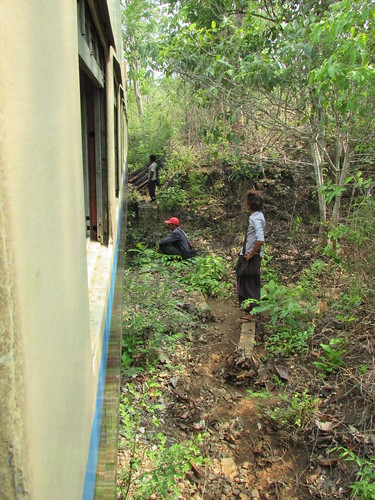
Track workers adjacent to a bridge where wooden sleepers are being renewed.
The driver then applied power as we struggled in and out of curving rock and shale cuttings high above a broad valley and passed through forests of bamboo.
In places, I saw the remains of a former railway telephone wire route which appeared to have once carried just two wires. The railway now seems to rely on a collection of fairly old technology radio systems for its communications and tall bamboo masts supporting an antenna can be seen at most stations. I noticed bridge number 167 before we passed over a level crossing equipped, unusually, with a continuously-sounding warning horn.
Smoking is now prohibited on Myanma Railways. From time to time, a smoker would pass through the coach to take a quiet smoke in the vestibule. Since the doors on these coaches are normally left open for ventilation and there are often massive openings around gangway connections, other passengers are not inconvenienced by this practice.
The train twisted and turned, running along a narrow 'shelf' cut into the contours the hills with a broad valley on one side and a rock and shale wall, with numerous trees relying on a precarious root-hold, on the other. The train didn't stop at Ye Bu but some two miles further on we paused at Le Byin where there is a platform line and three loops. A Carriage and Wagon Examiner appeared and walked down the train 'wheel-tapping' - a once-common sight in Britain. The sound of a tinkling bell told that an ice-lolly vendor was also working his was down the train. An indication of the elevation was given by the fact that the small, corrugated iron roofed station building was provided with a chimney for an internal fireplace. Everything around the station appeared neatly painted in black and white. Even the mast for the radio antenna was painted in black and white bands.
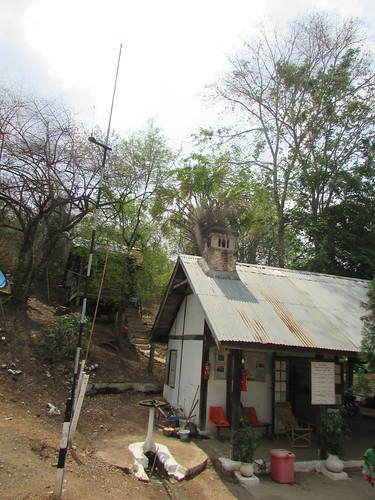
Le Byin station.
We departed at 10.20 a.m., passing another abandoned water column and a raft of loaded bogie ballast wagons parked in one of the loops. The points were operated by ordinary hand levers. After passing over a minor level crossing closed by hinging bamboo poles, we passed a group of pigs happily foraging along the trackside. I was intrigued by Le Byin's 'downhill' home signal - an attractive lattice post and finial with a corrugated steel upper quadrant arm (just an arm, not even a 'vestigial' spectacle). Mounted on the post was a mechanical 'slot', allowing control of the signal from two locations (there's a short description of 'slotting' here).
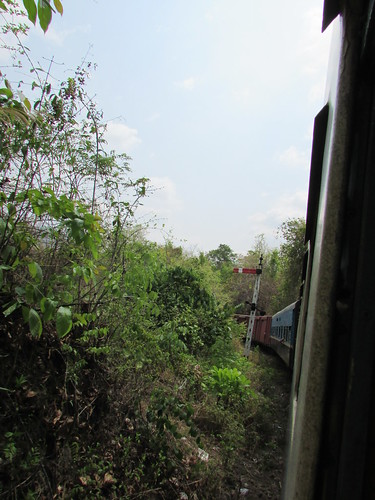
Le Byin's 'downhill' home signal with a mechanical 'slot'.
In the next 20 minutes, we passed a group of farmers restraining their oxen as the train passed, rock cuttings, glimpsed a large village in the valley on our left and came to the first 'Zig-Zag' where the line from Kalaw converged on our right at a scissors crossover. Beyond the scissors, there were two parallel tracks with a disused water column between them. We look the left line which was provided with a platform, station buildings and the standard wooden station nameboard solemnly labelled ZIT ZAT REVERSE (A). Beyond the nameboard, there was an elevated ground frame with red and yellow levers which I didn't get a decent look at. There was a wide assortment of semaphore signals - wooden post, lattice post, full arm, short arm but with corrugated arms and proper 'lower quadrant' style spectacle frames (no glass) arranged for upper quadrant working. As I've found elsewhere, not many signals actually seem to be worked and reliance is placed on handsignals given by flags in various shades of green. The platform was busy with passengers and vendors.
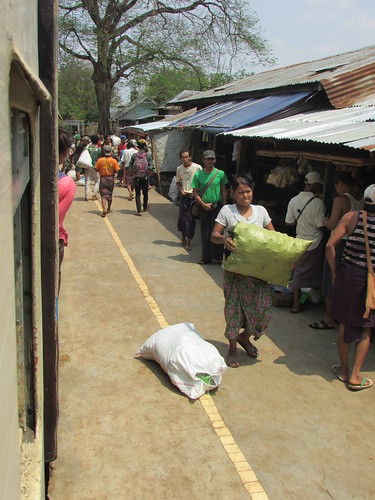
The platform at ZIT ZAT REVERSE (A).
After about seven minutes, during which time a member of the locomotive crew studied coach wheels, perhaps looking for dragging brakes, the points had been reversed and we set off backwards, the locomotive propelling the train which snaked onto the climbing Kalaw line. With the locomotive working hard, within a couple of minutes we were at the top of the Zig-Zag and passing a neat short-arm starting signal for the Kalaw line.
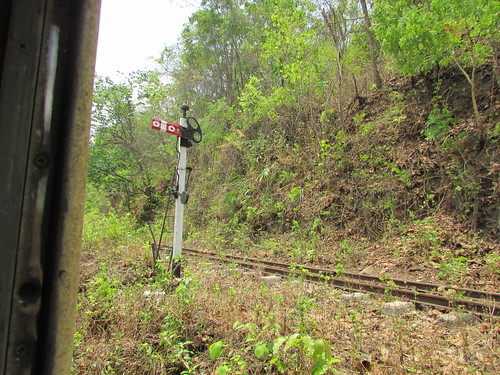 A neat, short-arm starting signal at the top of the first Zig-Zag.
A neat, short-arm starting signal at the top of the first Zig-Zag.
We came to a stand with the locomotive clear of the points which were changed to allow the train to proceed to Kalaw with the locomotive once more at the front of the train. I could see all three sections of the Zig-Zag as we continued out climb.
 The low level and middle levels of the zig-zag viewed from my train on the upper level.
The low level and middle levels of the zig-zag viewed from my train on the upper level.
It was now 11 o'clock and I was four hours into the journey.
The description of the rest of my jorney to Kalaw is here.
History
When the railway was first extended from Taungoo to Mandalay in the late 19th century, Thazi had not established itself. I found a reference only to 'Meiktila Road' (Meiktila is a town 14 miles west of Thazi). An early traveller to Kalaw had to complete the journey from Meiktila Road to Kalaw on horseback. But just as the British, having chosen Pyin Oo Lwin as a suitable Hill Station (and re-named it 'Maymyo' after a British officer), constructed a railway over difficult terrain linking Mandalay and Pyin Oo Lwin, so a similar line was provided from a junction with the Yangon - Mandalay main line over a similarly arduous route to Kalaw and beyond. The main line junction became Thazi and a town grew up around it.
Related posts in my blog
Thazi Railway Station and Diesel Locomotive Depot.
Thazi - Kalaw (part 2).
All my Myanma Railways posts.
My Pictures
Pictures in this article can be viewed uncropped by clicking on the image. To view in other resolutions or download, select from the album Thazi to Kalaw by Train.
All my Myanma Railways Pictures.
